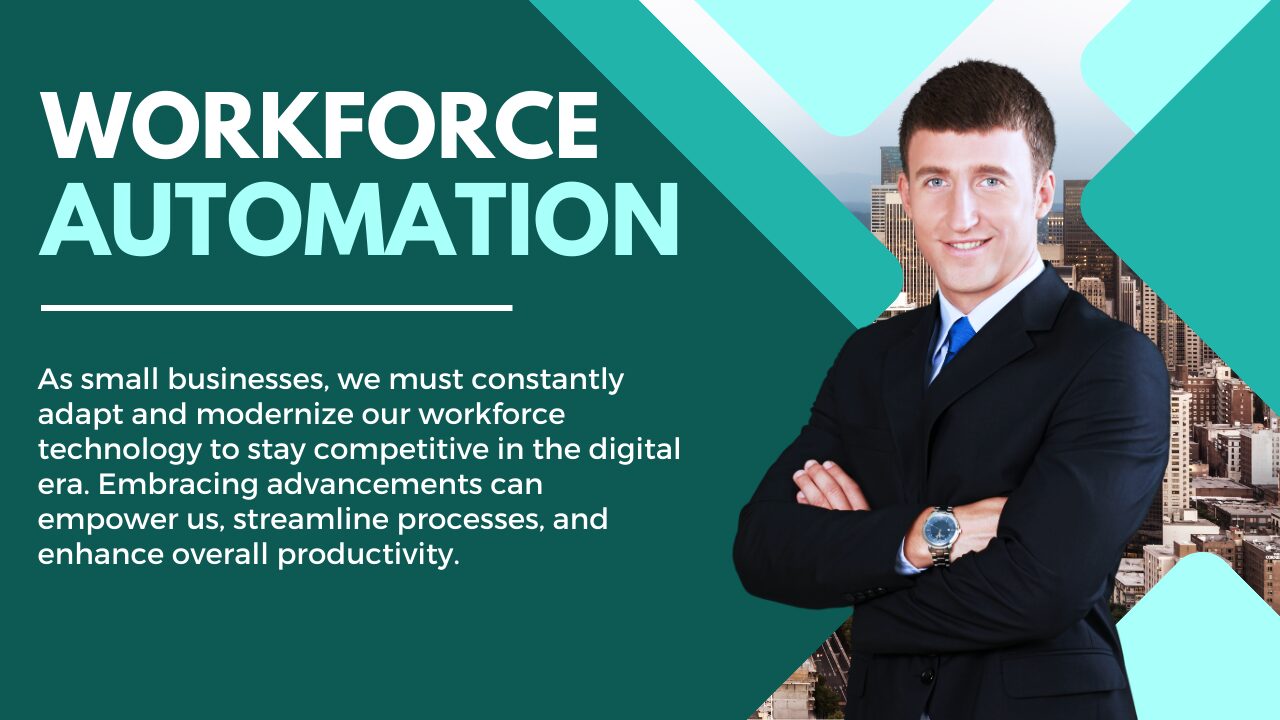How Small Businesses Can Approach Workforce Technology Modernization: Effective Strategies for Success
As small businesses, we must constantly adapt and modernize our workforce technology to stay competitive in the digital era. Embracing advancements can empower us, streamline processes, and enhance overall productivity. However, many small businesses struggle to keep up with these rapid changes. This section will discuss some strategies to approach workforce technology modernization.
Assessing Our Needs
It’s crucial to identify our specific needs and requirements to improve and modernize our workforce technology. We should examine our current systems and processes to determine which areas need improvement or modernization. Some examples of assessments include:
- Identifying outdated hardware or software
- Analyzing employee skill gaps
- Determining areas where automation can improve efficiency
Utilizing Cloud-based Solutions
Cloud-based technologies offer significant benefits for small businesses like ours. These platforms provide flexibility, scalability, and cost-effective solutions for managing and upgrading systems. By utilizing cloud-based solutions, we can easily:
- Access key data and applications from various devices
- Improve collaboration between team members
- Ensure better security and data backups
Investing in Employee Training
We need to improve our employees’ digital skills to make the most of modern technology. Training programs should equip our team with the necessary skills and knowledge to navigate the modern digital landscape effectively. We can:
- Provide regular training sessions and workshops
- Encourage online courses and certifications
- Offer learning resources and support
To successfully approach workforce technology modernization, we must be strategically adaptive and prioritize a people-centric approach. By doing so, we will be able to stay competitive and thrive in today’s digital era.

Reviewing Our Existing Technological Environment
Before we delve into modernizing our workforce technology, it’s essential to thoroughly assess our current technology landscape. This will help us identify areas that need improvement and ensure we make informed decisions throughout the modernization process.
- Determine where technology is lacking: Take a comprehensive look at the current technology and determine if it’s hindering our productivity or efficiency. This includes software systems, hardware, networking, and devices. Identify any bottlenecks, security risks, or other weaknesses in the system.
- Understand our workforce’s technical skills: Assess our team’s ability to use the technology we have in place. Identify areas where additional training may be needed and determine if knowledge gaps inhibit efficiency.
- Analyze the return on investment (ROI) of current systems: Consider the costs of maintaining existing technology compared to the potential benefits of modernization. Are outdated systems costing us more in maintenance than they’re worth? How much can we save or gain in productivity by upgrading our systems?
- Identify crucial goals for modernization: By reviewing our current technology landscape, we can determine which aspects of modernization are most important to our business, such as improving customer experience, streamlining operations, or enhancing data security.
- Establish priorities and timelines: We can create a prioritized plan for modernizing our workforce technology based on our analysis. This may include creating a timeline for reinvestment and identifying key milestones for upgrading or refining our systems.
In conclusion, thoroughly assessing our current technology landscape allows us to approach workforce technology modernization with clarity and confidence. By identifying weaknesses and setting priorities, we can ensure that our investments in modernizing technology benefit our business and empower our employees to work more effectively and efficiently.
Aligning Our Technology Goals with Business Objectives
As we modernize our workforce technology, small businesses like ours must focus on aligning technology goals with business objectives. This ensures that our investments in new technology serve the company’s growth and competitiveness.
Here are some important strategies to consider when aligning technology goals with business objectives:
- Define clear objectives: First, we must identify our strategic business goals, such as revenue growth, market expansion, or product innovation. Understanding these objectives helps in selecting the right technological solutions to support them.
- Assess the current state: Evaluate our existing technology infrastructure and identify areas that need improvement or modernization. This helps us to prioritize our tech investments by focusing on areas with the highest impact on our business goals.
- Choose appropriate technology: Select the right tools and solutions to enhance our workforce’s efficiency and productivity while aligning with our business objectives. These might include collaboration tools, automation solutions, or data analytics platforms.
- Invest in training: Ensure our team has adequate training to use the new technology effectively. Providing resources and ongoing support can increase the workforce’s adoption of modern tools and contribute to the achievement of our business objectives.
- Monitor progress and adjust: Regularly track the performance of our technology investments and their impact on our business objectives. This allows us to make informed decisions on adjusting our strategy, adopting new tools, or reallocating resources as needed.
By following these guidelines, our small business can successfully approach workforce technology modernization while keeping our technology goals in line with our overall business objectives.
Focus on Cloud Adoption
As we delve into workforce technology modernization for small businesses, we must emphasize the significance of cloud adoption. Integrating cloud-based solutions can greatly benefit small businesses in multiple ways:
- Scalability: Cloud services allow businesses to expand and shrink their resources as needed, making it an ideal solution for growth and changing requirements.
- Cost-effectiveness: By adopting cloud-based solutions, small businesses can reduce upfront expenses related to hardware and software. Cloud services often operate on a subscription basis, making it more affordable for small businesses.
- Data accessibility: Storing and accessing data becomes seamless with cloud platforms, allowing employees to access critical information from anywhere, as long as they have an internet connection.
- Collaboration and productivity: Cloud-based tools enable teams to collaborate effectively in real-time, streamlining communication and workflows.
Some prominent cloud platforms that small businesses can consider for modernizing their workforce technology include:
- Amazon Web Services (AWS): A comprehensive platform with a vast array of services ranging from computing to analytics, designed to support businesses of all sizes.
- Microsoft Azure: A versatile cloud platform that offers a variety of solutions such as virtual machines, databases, and AI services.
- Google Cloud: Known for its robust infrastructure, Google Cloud provides an array of solutions designed to optimize efficiency and innovation.
By focusing on cloud adoption, we can effectively guide small businesses on the path toward workforce technology modernization. With a wide range of solutions, these cloud platforms enable enterprises to stay competitive and agile in an ever-evolving digital landscape.
Invest in Collaborative Tools
As we modernize our workforce technology, small businesses must integrate collaborative tools into their daily operations. These tools facilitate communication and teamwork, contributing to overall efficiency and productivity. Here are some essential aspects to consider when investing in collaborative tools:
- Cloud-based solutions: Opt for tools that offer cloud-based capabilities, such as Microsoft Teams or Slack. These platforms provide real-time communication and collaboration, enhancing accessibility and data security.
- User-friendly interfaces: Choose tools with intuitive and easy-to-use interfaces, ensuring that the team can quickly adapt and fully utilize them.
- Scalability: Select systems that can grow alongside your business, accommodating increased size and complexity without compromising performance.
- Integration: Invest in tools that integrate seamlessly with other software and systems you use, streamlining workflows and data sharing.
By prioritizing these aspects, we can successfully invest in collaborative tools that support the ongoing modernization of our small business workforce technology.
Focusing on Cybersecurity Measures
As we modernize our workforce technology, we must prioritize cybersecurity. Cyber threats are becoming increasingly prevalent, and small businesses need to be prepared to face them. Here are some key steps we can take to enhance our cybersecurity measures:
- Implement strong security policies: Develop and enforce robust policies that cover password management, access control, and data handling practices. Regularly review and update these policies as needed.
- Invest in advanced security software: Use comprehensive security software to protect our systems from malware, phishing attacks, ransomware, and other cyber threats. Keep software up-to-date with the latest security patches.
- Educate employees about cyber risks: Conduct regular training sessions to teach our team about the potential threats they might face, how to recognize them, and how to respond appropriately. This can include phishing simulations, security awareness workshops, and more.
- Regularly assess and monitor our systems: Conduct routine vulnerability assessments and penetration tests to identify and address potential security weaknesses in our technology infrastructure. Implement strong monitoring tools to track any suspicious activity or potential intrusions.
By prioritizing cybersecurity, we can protect our sensitive data, customer information, and essential business assets while modernizing our workforce technology. This will ensure that our technology remains secure and contribute to our business’s ongoing success and competitiveness.
Embrace Mobile-Friendly Solutions
As we consider how small businesses can approach workforce technology modernization, we must recognize the potential of mobile-friendly solutions. Integrating mobile technologies into the workplace can help businesses stay relevant, adapt to the ever-changing digital landscape, and empower their employees. Here are some ways small businesses can embrace mobile-friendly solutions:
- Enable remote access: By providing employees with tools to access company systems from their mobile devices, we can enable remote work, increase productivity, and maintain communication between team members.
- Opt for mobile-first applications: When selecting software for our businesses, prioritizing applications that have been designed with mobile devices in mind can ensure a seamless user experience for employees and improve overall efficiency.
- Adopt cloud-based technologies: Cloud-based solutions can enhance the mobile accessibility of crucial business data and applications, making our workforce more flexible and responsive to business needs.
- Invest in mobile security: Protecting sensitive business data is critical; therefore, incorporating mobile device management (MDM) and secure access protocols should be a priority when embracing mobile-friendly technology.
By implementing mobile-friendly solutions in our small businesses, we can promote workforce technology modernization and adapt to the digital era, allowing our companies to thrive and stay competitive.
Examine Remote Work Possibilities
In today’s digital era, small businesses must consider the benefits of embracing remote work. This can be a strategic approach to workforce technology modernization as it enhances efficiency and productivity. Here are a few key points to consider when assessing remote work options:
- Remote work technology: Adopting collaboration and communication tools such as project management systems, video conferencing, and messaging platforms is crucial for supporting remote employees. These technologies will enable seamless team communication, collaboration, and coordination.
- Talent acquisition: Remote work allows businesses to expand their talent pool and access skilled professionals from across the globe. It enables hiring the most capable individuals without the restrictions imposed by geographical proximity, ultimately driving business growth.
- Improved productivity: Studies have shown that employees often experience increased productivity and satisfaction when working remotely. Implementing remote work options can result in a happier and more efficient workforce.
- Cost savings: Introducing remote work opportunities can lead to cost savings for small businesses, as remote workers often require less office space and resources. Focusing on technology that supports remote work can ultimately reduce overhead costs.
As we modernize our workforce technology, remote work options can be essential in keeping small businesses competitive and agile. Investing in appropriate tools, infrastructure, and strategies that effectively support remote working environments is important.
Consider Automation for Efficiency
As we continue discussing how small businesses can approach workforce technology modernization, let’s focus on the importance of automation for enhancing efficiency.
Utilizing automation can drive growth and improve efficiency for small businesses. By automating repetitive and time-consuming tasks, businesses can save time, reduce errors, and allow their workforce to focus on more strategic and impactful tasks. Here are some key areas that can benefit from automation:
- Data Management: Automate data entry, backups, and syncing across multiple platforms.
- Customer Support: Implement chatbots to handle frequently asked questions, reducing the load on customer service representatives.
- Invoicing and Payments: Automate invoice generation, payment reminders, and payment processing.
- Marketing and Sales: Use email marketing tools to automate email campaigns, lead nurturing, and social media scheduling.
- Human Resources: Automate employee onboarding, time tracking, and performance management.
- Project Management: Utilize tools to automate task allocation, progress tracking, and collaboration.
To get started with automation, we recommend the following steps:
- Identify repetitive and time-consuming tasks that can be automated within your business.
- Research and evaluate automation tools and solutions that best fit your business needs.
- Train your workforce to use the chosen automation tools effectively.
- Monitor and optimize automation processes over time based on your business goals.
In conclusion, embracing automation is vital to workforce technology modernization for small businesses. By incorporating automation into various processes, small businesses can boost efficiency, reduce costs, and stay competitive in today’s digital landscape.
Ongoing Training and Support for Workforce Technology Modernization
As we modernize our workforce technology, we must provide ongoing employee training and support. Investing in comprehensive training programs ensures our team has the necessary skills to navigate and leverage new technologies effectively. Here are some key points to consider when implementing training and support for small businesses:
- Skill development: Focus on developing essential skills and adapting to various tools and technologies. This includes critical thinking, problem-solving, and adaptability.
- Tailored training: Design training programs that cater to the diverse needs of our employees, considering different skill levels and learning styles.
- Regular updates: Keep employees informed about technological advancements and updates. Encourage a culture of continuous learning by organizing periodic training sessions.
- Accessible resources: Provide easy access to resources, such as instructional guides, video tutorials, and online courses. This enables employees to learn at their own pace and enhances their skill set.
- Mentorship program: Foster mentor-mentee relationships among our employees to encourage knowledge sharing and provide guidance.
By adopting these strategies, we can instill a culture of continuous improvement and support our workforce technology modernization efforts. Ultimately, this will lead to increased productivity, efficiency, and the overall competitiveness of our small business in the digital era.
Adapting to Ever-Changing Technologies
As we progress in the digital age, small businesses must stay ahead of the curve by keeping up with the rapid evolution of technology. This ensures our business remains competitive and our workforce is competent. Here are some key aspects to consider when modernizing workforce technology:
- Continuous Learning: Empower employees with ongoing training and development programs to boost their skills in using current tools and prepare them to adapt to emerging technologies.
- Proactive Approach: Be aware of new technological solutions within your industry and closely observe the current trends. This enables you to make informed decisions about potential upgrades and improvements.
- Cloud-Based Solutions: Utilizing cloud-based applications and services simplifies upgrades and often provides better security features. It also allows for seamless collaboration among team members regardless of their location.
- Scalability: Choose technology solutions that can grow with your business. As your workforce expands or your business needs change, your chosen tools should be able to adapt as well.
- User Experience: Prioritize technologies that are user-friendly and have intuitive interfaces. This will make it easier for your employees to learn and adapt to new tools, reducing training time and increasing productivity.
By paying attention to these factors, we can ensure that our small businesses benefit from the latest technological advancements and that our workforce remains skilled in using the most up-to-date tools and systems.
Need Help Upgrading Your Workforce Technology?
Upgrading workforce technology might seem daunting, but it’s necessary for small businesses to remain competitive in the digital age. We’re here to help you navigate this process strategically and align it with your business goals. By employing practical strategies and leveraging modern technology, we can enhance your operational capabilities and set your business up for long-term success.
Contact us to discuss how we can assist you in modernizing your workforce technology.







